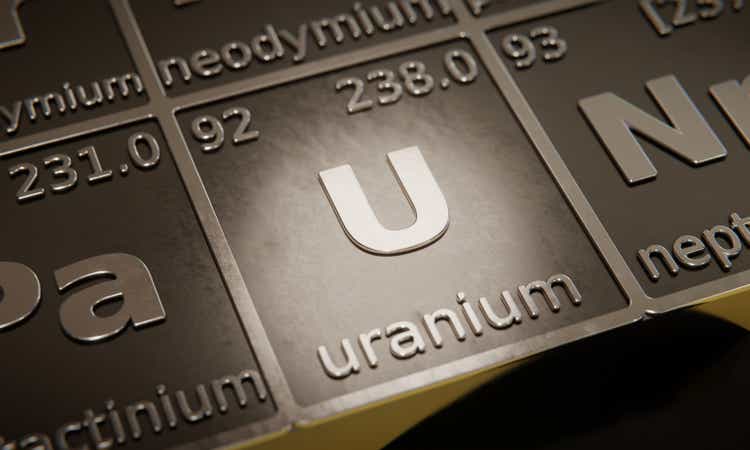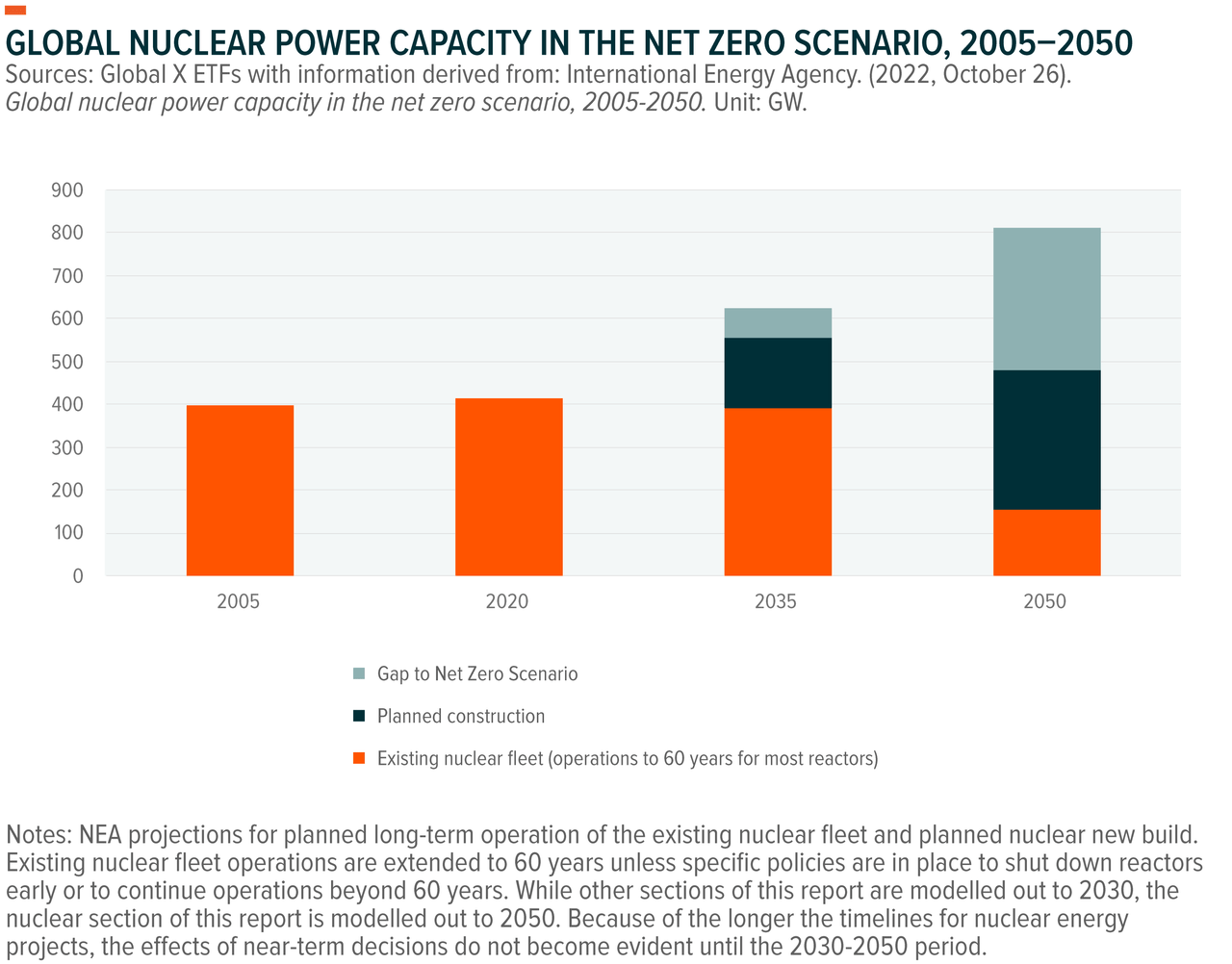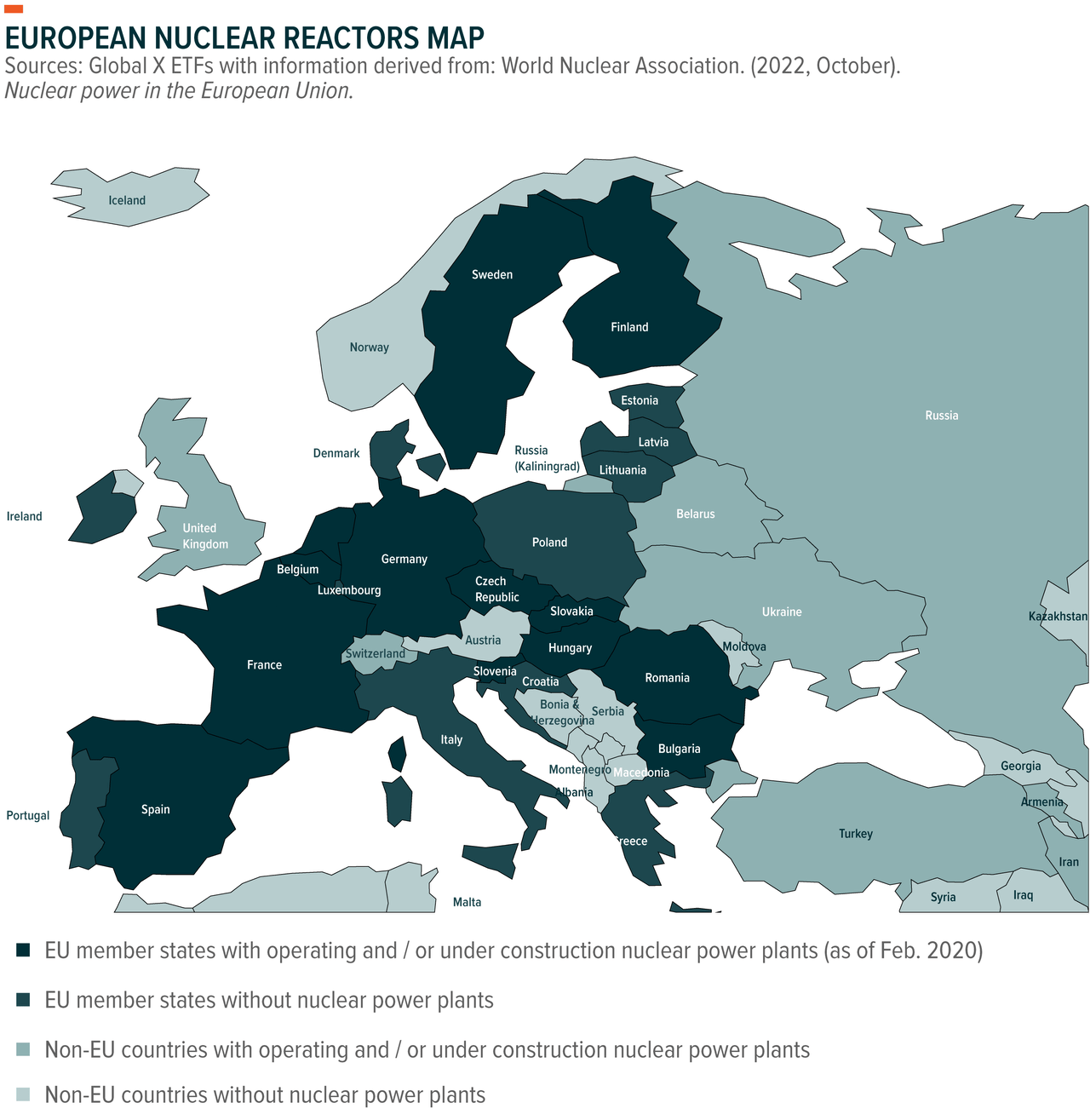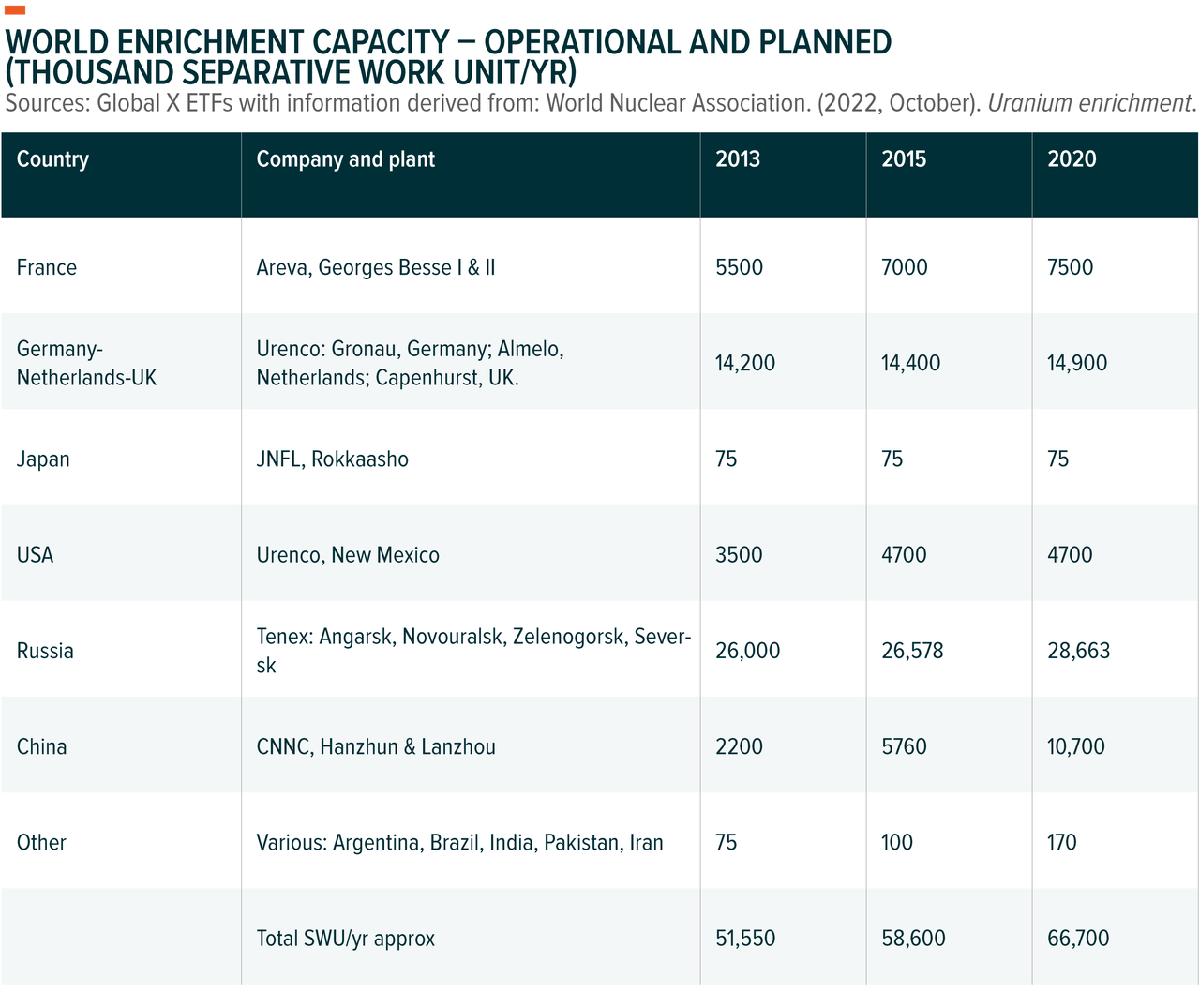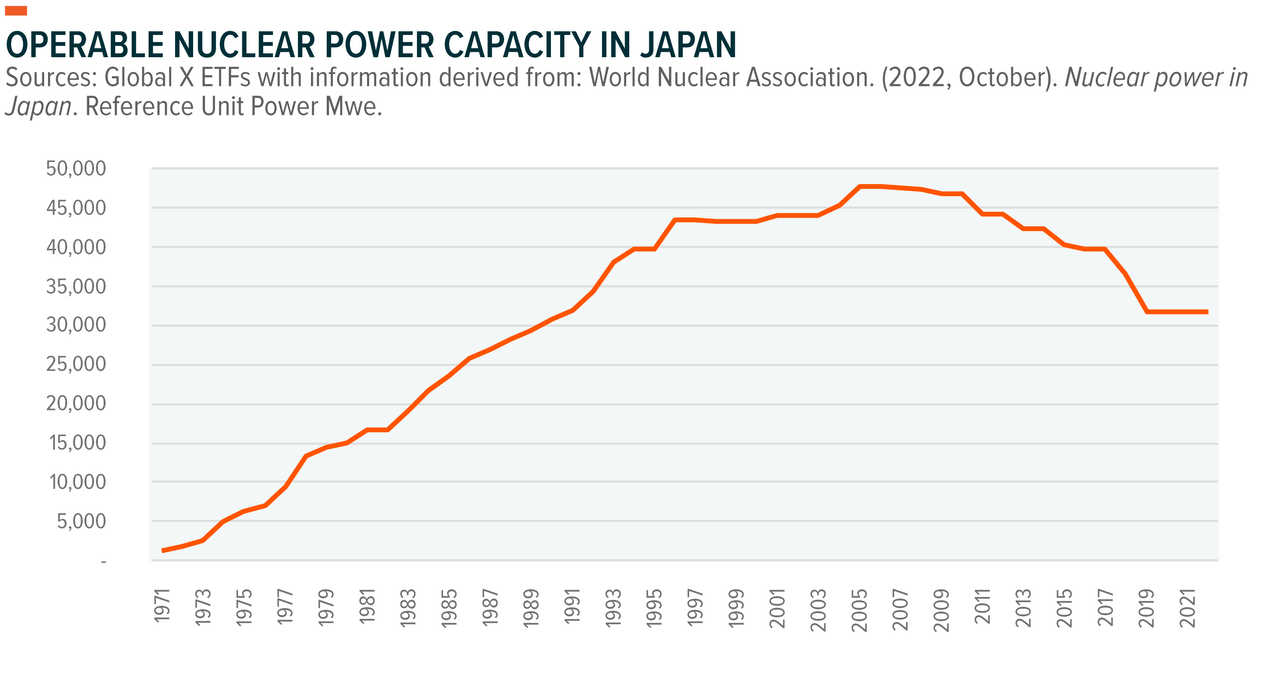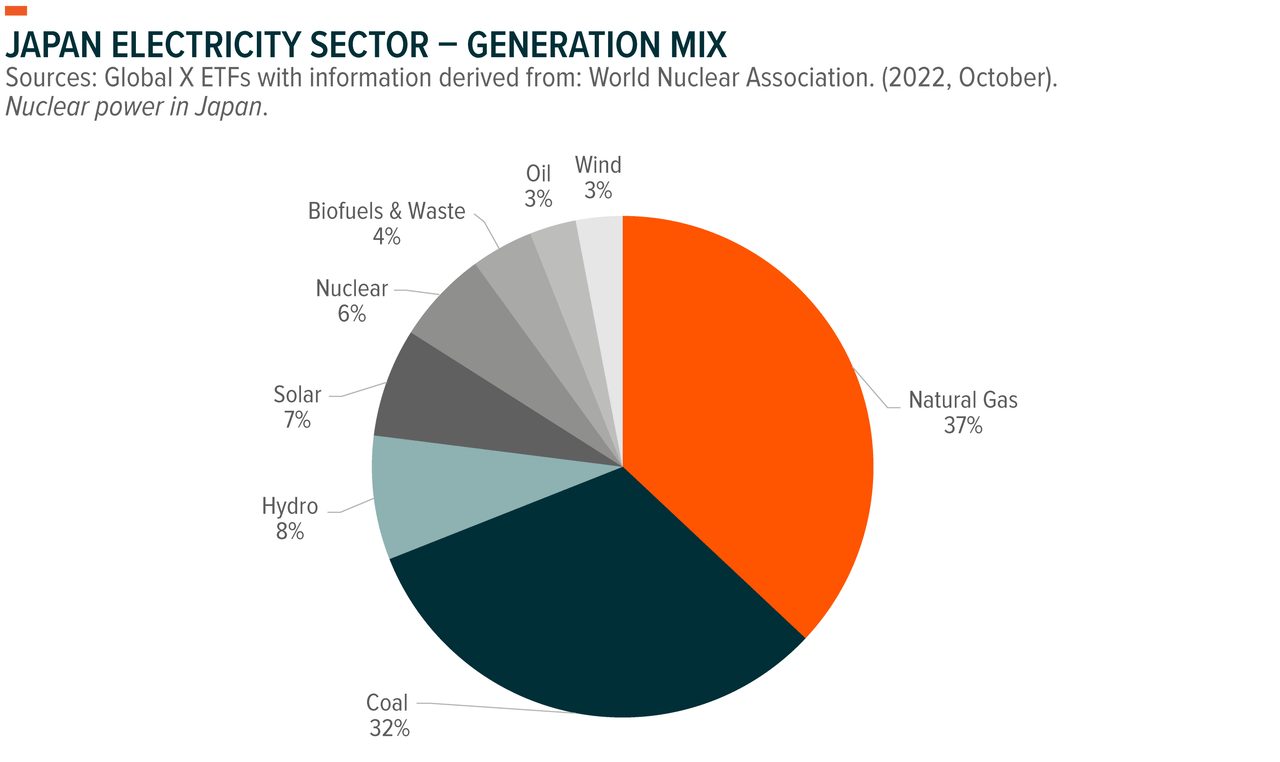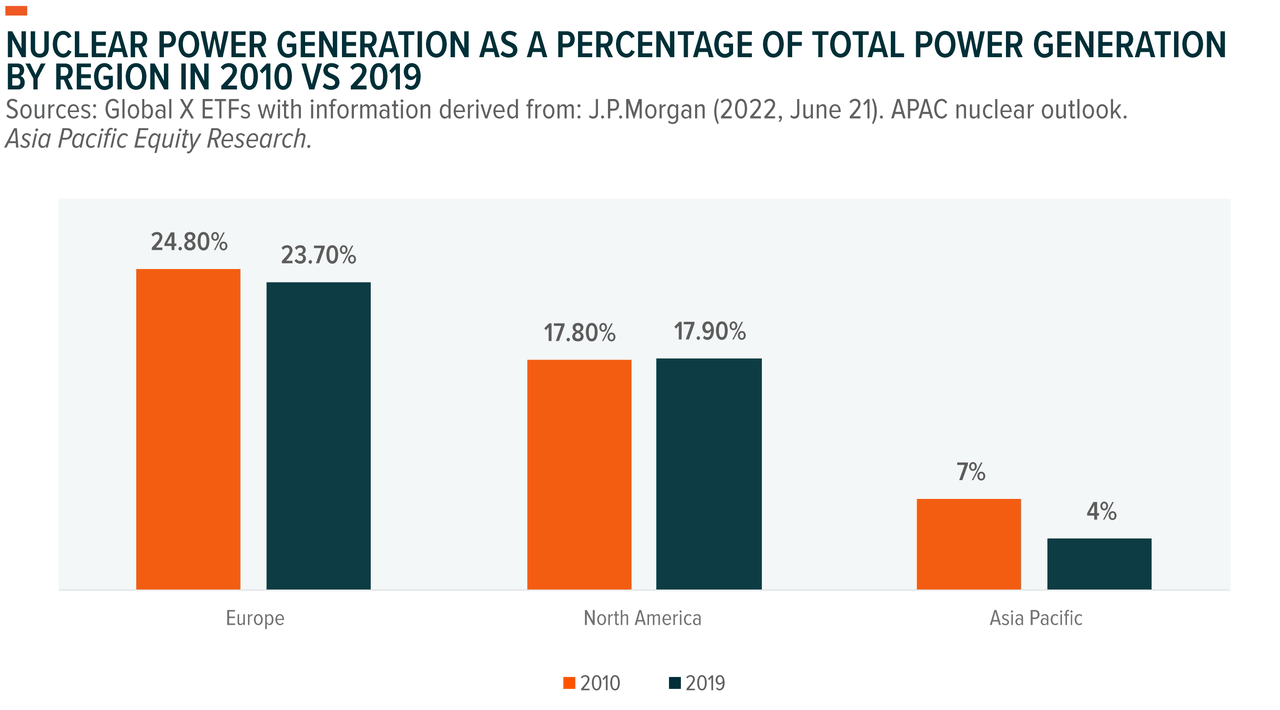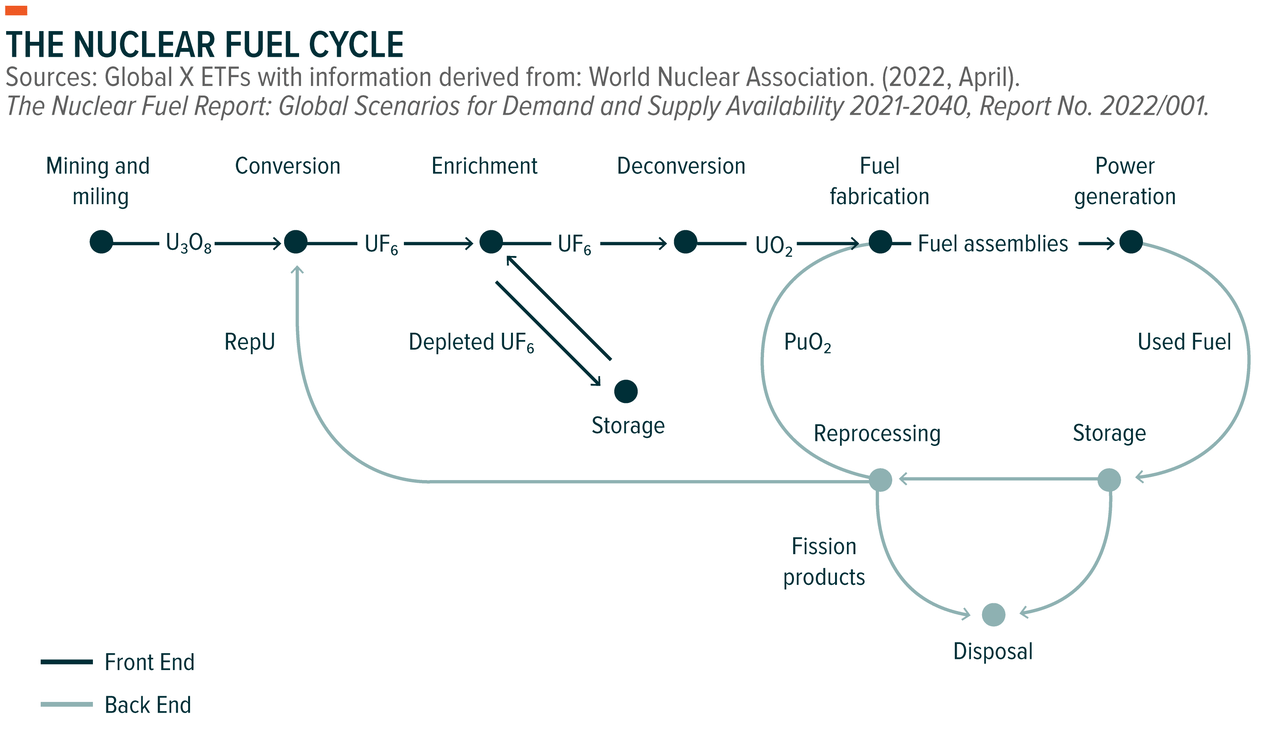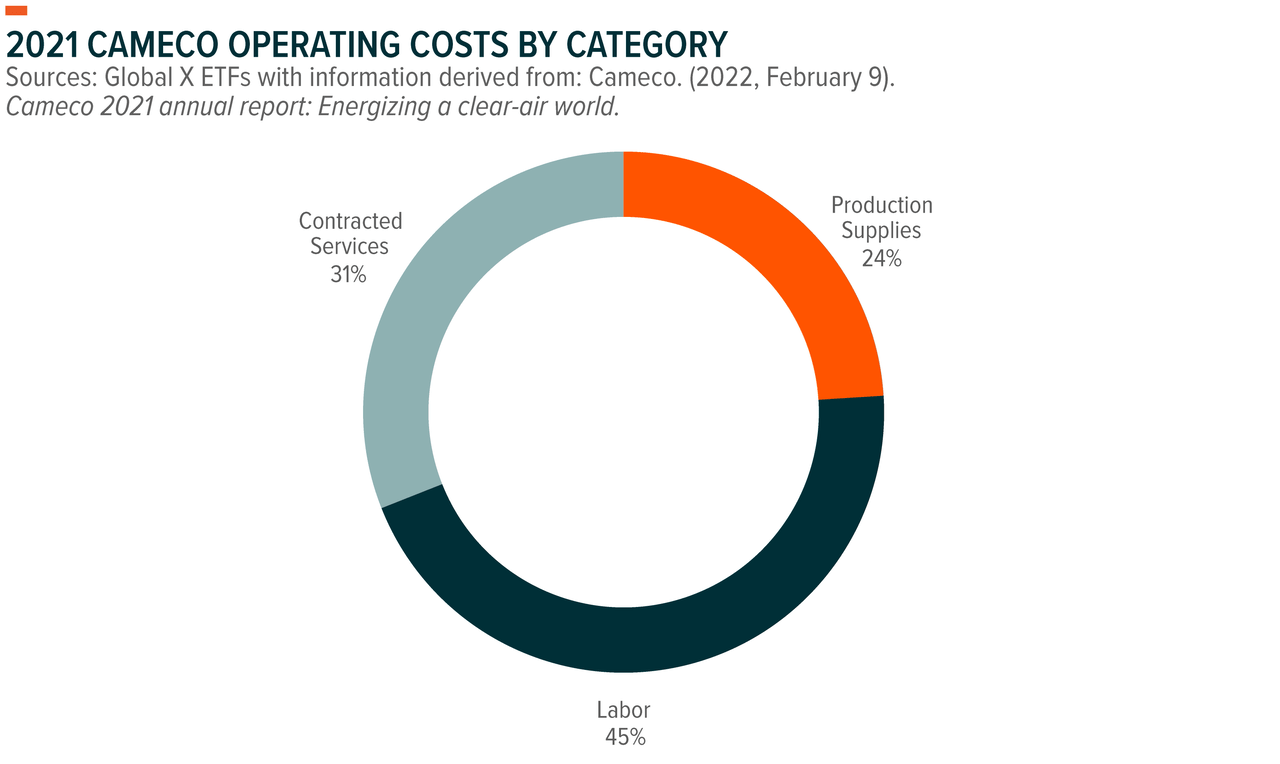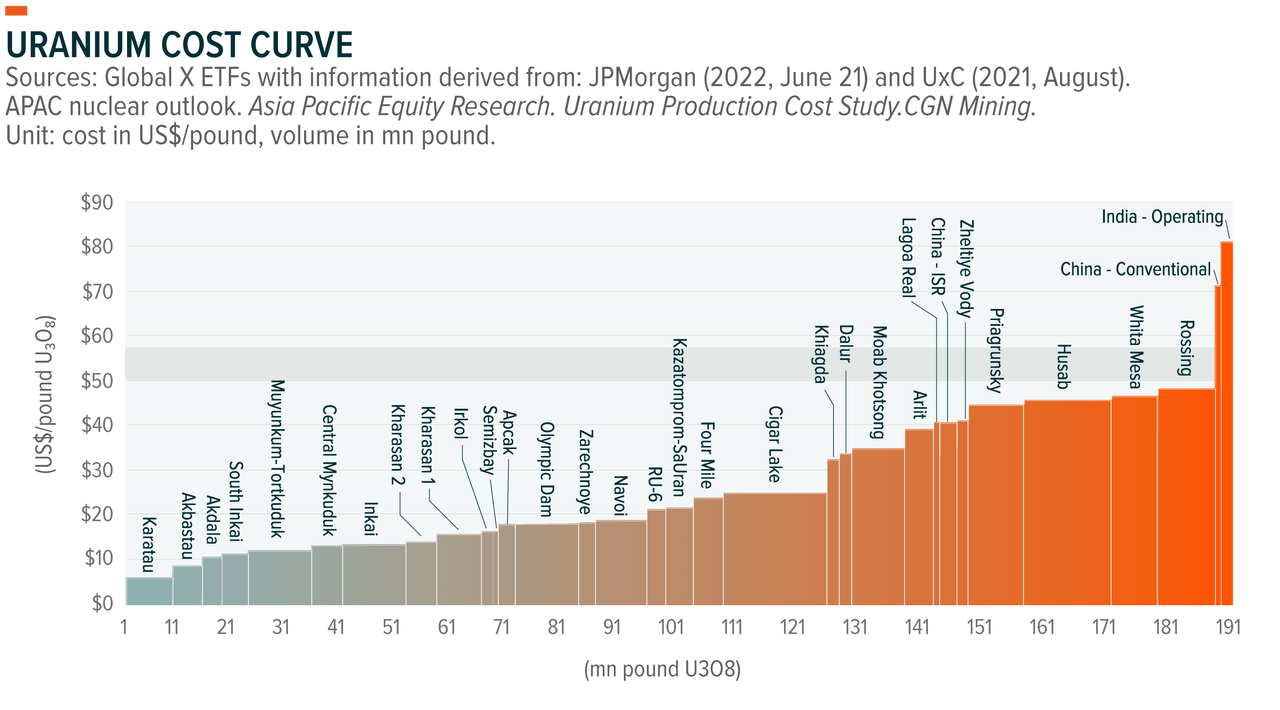Interesting article from seeking alpha
https://seekingalpha.com/article/4561687-uranium-nuclear-green-narrative-intensifying-and-energy-security-now-essentialUranium 2.0: Nuclear's Green Narrative Is Intensifying, And Energy Security Is Now Essential
Dec. 01, 2022 8:54 AM ETURASummary
- The conversation about nuclear power as a tool to address climate change continues to gain steam.
- In Europe, nuclear technologies are “transition activities” under the EU Green Taxonomy, a classification that should improve investor confidence in uranium.
- Radioactive waste is among the key risks associated with nuclear power plants.
- Uranium has little trading volume on futures platforms and is subject to ownership limitations, which makes it more challenging to acquire exposure than other commodities.
HT Ganzo
The need to decarbonize the global economy, find a reliable energy supply, and meet rising energy demand has an interest in nuclear power surging. A root cause of the interest in nuclear power, and renewables in general, is Russia’s invasion of Ukraine shifting the world’s energy landscape. European Union (EU) governments continue to warn of a gas emergency with the EU cut off from Russian gas supplies, and they are preparing for a total stoppage this winter. In this report, the latest in our uranium series that includes Uranium, Explained, Nuclear Energy and Uranium Moving Into the Mainstream, and Uranium Market Primed for Growth, we highlight how the current environment has the world embracing nuclear energy as critical to the energy transition and long-term energy security.
Key Takeaways
- We expect nuclear to be a climate change solution based on the U.S. Inflation Reduction Act and a “transition activity” under EU Green Taxonomy, which should boost uranium investment.
- With Europe in an energy crisis, countries may begin to stockpile uranium for use as a backup power source. The enrichment market could change and extend output amid an increase in nuclear energy and uranium demand.
- In terms of perceived risks with nuclear energy, the industry has implemented safe and technologically proven means to transport, store, and dispose of nuclear waste. Also, cost guidance will likely increase across the global mining sector; however, in the uranium industry, most operational expenses are set or hedged against inflation.
Green Energy Transition Readying for a Nuclear Boost
The conversation about nuclear power as a tool to address climate change continues to gain steam. According to the International Energy Agency (IEA), for the world to meet net zero emissions goals, the nuclear sector must double in size over the next two decades (“the Net Zero Scenario”).1 Recent policy may help, as the Inflation Reduction Act (IRA) in the U.S. is predicted to increase investment in the uranium sector, strengthening nuclear energy as a climate solution. The bill, touted as the biggest climate investment in U.S. history, will:
- Establish a nuclear power production tax credit to support current nuclear generators, expanding on the Civil Nuclear Credit Program. The tax credit runs from 2024 to 2032.2
- Swap technology-specific renewable energy tax credits for technology-neutral credits that place advanced nuclear energy on par with other zero-carbon energy generation. The tax credits can be used for production or investment beginning in 2025.3
- Support fuel supply projects for advanced reactors that produce high-assay low-enriched uranium (HALEU), which can make advanced reactors smaller, require less frequent refueling, and be less wasteful. The bill provides $600 million to the HALEU program to buy enriched HALEU or obtain it by processing Department of Energy (DOE) stockpiles. Additionally, $100 million is for developing suitable HALEU transport.4
In Europe, nuclear technologies are “transition activities” under the EU Green Taxonomy, a classification that should improve investor confidence in uranium. In July 2022, the European Parliament didn’t object to the Commission’s Taxonomy Complementary Delegated Act, which, therefore will be in effect starting January 2023 with nuclear energy classified as green energy.5 Research, development, and deployment of cutting-edge technologies that reduce nuclear waste and heighten security, a class of reactors known as Generation IV, are among the nuclear-related actions included in the taxonomy.
Europe’s Energy Crisis Makes Energy Security a Priority
EU governments issued early warnings of a gas emergency due to Russia’s decision to reduce gas supply through the Nord Stream pipeline, and they continue to sound the alarm. Currently, Europe is preparing for a total shut-off of Russian gas shipments this winter. To escape the crisis, the IEA highlighted the need for a “massive surge” in investment to speed up the transition to clean energy.6
As part of this surge, nuclear power is being promoted as a clean energy alternative that can help improve energy independence. The ability to store uranium as a strategic reserve to secure energy supply is another way in which nuclear power can help countries achieve energy security, in addition to the fact that nuclear is the most dependable energy source because it has the largest capacity factor, as previously noted. France’s longstanding energy security strategy relies heavily on nuclear power, and the country accounted for more than half of EU uranium demand as of March 2022, followed by Spain, Sweden, and Belgium.7
In 2020, the European Atomic Energy Community (Euratom) reported that EU-27 utilities received 12,592 tonnes of mined uranium, or about 26% of the world’s supply from mines.8 Niger, Russia, Kazakhstan, Canada, Australia, and Namibia were the key suppliers.9 Most nations that mine uranium do not produce nuclear power, so uranium transport is vital. Since 1961, International Atomic Energy Agency (IAEA) standards have governed radioactive material shipping. Uranium oxide concentrate, known as yellowcake, is carried from mines to conversion plants by road, rail, and ship in 200-litre drums, each holding about 400 kg U3O8, packed into shipping containers.10
In the wake of Russia’s invasion of Ukraine, governments around the world are revisiting commodities supply chains and trade management, especially in the energy sector. On this path, potential sanctions on uranium imports from Russia have also been considered. 11 On the other side, the risk of Russia halting uranium exports as a retaliatory measure also supports the need to reduce Russian imports of nuclear-reactor fuel.
Potential sanctions on Russian uranium, which represents 6% of the global uranium supply, are likely to affect the broader market, making it even tighter than it already is.12 According to the European Atomic Energy Community, the uranium that originates outside the EU-27 accounts for 95% of EU domestic total consumption, and Russia is the second-biggest source of uranium for EU member states behind Niger.13
Russia has roughly 43% of the global enrichment capacity, Europe 33%, China 16%, and the U.S. 7%.14 Some spare capacity can be found in the U.S. and Europe. China is expanding its capacity considerably, in line with domestic requirements.
The Biden administration introduced legislation “to build a stronger domestic nuclear fuel supply for the future” under a Nuclear Fuel Security Program.15 This legislation can be viewed as an attempt to wean off Russian uranium imports, which the U.S. is somewhat reliant on currently. Russia accounts for 16.5% of the uranium imported into the U.S. and 23% of the enriched uranium needed to power U.S. commercial nuclear reactors.16
The opportunity for the U.S. uranium industry is significant, as the country has only one commercial enrichment facility, owned by Urenco Ltd. The administration’s $4.3 billion investment would go toward buying low-enriched and other forms of uranium directly from U.S. producers, boosting domestic manufacturing and securing fuel for the advanced reactors now under development.
The Asia-Pacific Region Is Essential to the Nuclear Industry’s Growth
Nuclear power only accounts for 4% of the energy market in Asia-Pacific (APAC), compared to 24% in Europe, the Middle East, and Africa (EMEA) and 18% in the Americas.17 However, APAC is crucial for the expansion of the nuclear industry; most countries including Japan, China, India, and South Korea, have a nuclear program in development. For example, South Korea has a 15-year energy strategy. Under the plan, nuclear power would account for about one-third of the country’s energy mix by 2030, enhancing energy security and fulfilling climate targets.18
In Japan, Prime Minister Fumio Kishida aims to reestablish Japan as a nuclear-powered nation for the first time since the 2011 Fukushima disaster.19 Before Fukushima, Japan derived almost one-third of its power from nuclear reactors.20 According to the International Atomic Energy Agency, Japan had 50 generating reactors, but 46 were shut down following the tragedy.21 As a result, in the years since, Asia’s most advanced economy has consumed more coal, natural gas, and fuel oil, despite its goal to attain net zero carbon emissions by 2050. As of June 2022, the World Nuclear Association said that Japan needs to import about 90% of its energy requirements.22 For Japan to achieve its goal of becoming carbon neutral by 2050, nuclear power may be required.
Finally, China’s nuclear industry has expressed confidence in its ability to speed its expansion plans. The China Nuclear Energy Association considers 6–8 new reactors a year through 2025 a reasonable goal, with as many as 10 also possible.23 As we noted in Uranium, Explained, China has the most ambitious nuclear program with plans to construct roughly 150 new reactors in less than two decades. If completed, China would triple its nuclear energy capacity and become the world’s largest nuclear power producer, ahead of the EU and the U.S.
Uranium Enrichment Is Key to Getting the Ball Rolling
To generate nuclear energy, the utilities that buy uranium from the mines need a certain quantity of enriched uranium. Uranium consists of two main isotopes, U-235 and U-238, that are chemically identical but different in mass. Their difference in mass allows the isotopes to be separated and makes it possible to increase, or “enrich,” the percentage of U-235. The fission of the U-235 atoms generates nuclear energy. Lower levels of enriched uranium, such as uranium with 5% U-235, are commonly used for nuclear reactor fuel.
Historically, the uranium enrichment process has a good degree of inertia. Even when enriched uranium demand declined following the Fukushima accident, enrichment plants continued operating because it was costly to shut down and re-start centrifuges.
Primary and secondary supplies are the two basic divisions of uranium supply. Mined and processed uranium is referred to as the primary supply, while reprocessed uranium that is added back into the fuel cycle is the secondary supply.
The ability to redirect excess enrichment supply to uranium production by underfeeding (operating at low tails assay) affects the secondary uranium supply. Currently, enrichment facilities are underfeeding because of the oversupply of enrichment capacity worldwide. Underfeeding is more prominent since the implementation of centrifuge technology, and gas centrifuges need to remain online even as enrichment demand drops away. A centrifuge is required to spin continuously for long periods.
However, the enrichment market could change and extend output amid an increase in nuclear energy and uranium demand. In line with this expectation, Urenco, one of the leading international suppliers of enrichment services, stated in its most recent annual report that “The enrichment market is recovering and now approaching a level which allows us to plan for reinvestment in plant capacity.”24 In addition, a potential ban on Russian enriched uranium from the U.S. and the EU would likely lead other enrichment plants to step in. Capacity at enrichment facilities would have to be ramped up, leading to overfeeding.
Structural Risks: Nuclear Waste
Radioactive waste is among the key risks associated with nuclear power plants. However, nuclear power generates little waste, and the waste that it does generate is carefully controlled. All U.S. nuclear power reactors store spent nuclear material in thick concrete with steel liners 40 feet underwater.25
Used fuel assemblies cool in a pool after being removed from a reactor. The pool and water protect employees from radiation. The fuel is usually pool-cooled for five years before being casked. The waste is then stored for about 40 years in dry casks which are enormous steel-reinforced concrete containers.26 Indeed, these barrels are for long-term storage until a disposal location is available. The two main types of nuclear waste are front end and back end. Front-end nuclear waste comes from uranium mining and contains depleted radium, which is incredibly dense and commonly repurposed into tank shells and other durable metals. Back-end nuclear waste is gamma-radiated spent fuel rods with long half-lives.
As seen, after being removed from the reactor for about five years, spent fuel is transported to dry casks. Since the 1970s, the global nuclear business has completed more than 2,500 cask shipments of spent fuel without radioactive emissions, casualties, or environmental damage.27
Nuclear power generates much less waste than thermal power, for example. Since the 1950s, the U.S. has generated just 90,000 metric tonnes of wasted fuel, which could fit on a single football field 10 yards deep.28 The nuclear industry has devised safe and technologically proven means to transport, store, and dispose of radioactive waste. Radioactive waste accounts for less than 10% of all hazardous items carried annually in the U.S.29
When compared to other types of industry, the nuclear power business generates relatively little waste. Globally, the vast majority, or 97%, of waste is considered to be either light or moderate (LLW ). Toxic materials of this type have been routinely disposed of in near-surface repositories for decades. In France, for example, only 0.2% of radioactive waste is considered high-level waste (HLW), despite the country’s extensive fuel reprocessing industry. 30
Because radioactive waste is handled carefully and decays naturally, it shouldn’t be too much of a concern for nuclear power plants. In addition, the U.S. Department of Energy announced up to $40 million in financing for a new Advanced Research Projects Agency-Energy (ARPA-E) initiative. This program will restrict waste from advanced nuclear reactors, safeguarding the land and air and promoting nuclear power as a stable source of clean energy.31
Contingent Risks: Cost Inflation
The global mining sector will likely report higher-cost guidance for 2022 due to inflation. Like all mining companies, uranium mining companies are affected by the cost of inputs such as fuel and labor, which is their most significant cost category. For example, labor accounted for 45% of Cameco’s costs in 2021, contracted services 31%, and production supplies 24%.32 Also, uranium implies a lower transport cost than coal, oil and gas due partly to the high energy density.
We expect the overall impact of price changes on mining cash flows to be small and mining companies to continue to provide a solid revenue stream. According to Cameco, “Uranium prices will need to reflect the cost of bringing on new primary production to meet growing demand.”33 Uranium mining companies have large, creditworthy customers that continue to need uranium despite fluctuations in economic conditions.
Uranium demand from utilities has been consistent. Utilities typically purchase their requirements many years in advance, taking into account the long time it takes to process and convert natural uranium into fuel assemblies. Power plants usually locate sources of uranium 12–24 months ahead of its projected usage.34 Once found, negotiations typically translate into long-term contracts ranging 3–15 years.35 Long-term contract arrangements suit utilities because they know their forward requirements many years in advance, and they serve the uranium miners by providing stability.
Typically, long-term commitments include a mix of fixed-price, base-escalated pricing, and market-related pricing mechanisms. Base-escalated contracts use a pricing mechanism based on a term-price indicator when the contract is accepted and escalated over the contract term. A base price is agreed to and fixed in the contract. It is also agreed that this price will escalate, generally in line with inflation. For example, the escalator could be the U.S. Consumer Price Index, to essentially prevent the contract from devaluing in real terms.36
The inflation hedging and the focus on keeping operating margins high and costs lean should mitigate large spikes in miners’ output as miners increase production based on contracted utility demand. In addition, the uranium industry is investing in new technology and business process improvements that can help keep costs in check. Also working in favor of cost control is that the preferred method for extracting uranium, In Situ Leach (ISL) mining, is the most cost-effective and environmentally acceptable method of mining available today. In 2019, this method accounted for 57% of the world’s mined uranium mined.37
According to the cost curve, the increase in the uranium price to US$50 per pound may cause worldwide uranium capacity to increase. Indeed, when the price of uranium reaches US$50 per pound, some mines may find it profitable to resume operations.38
Investing in Uranium and Nuclear Components
Uranium has little trading volume on futures platforms and is subject to ownership limitations, which makes it more challenging to acquire exposure than other commodities. Given uranium’s complexities, investing in an exchange-traded fund (ETF) with exposure to the uranium industry may be a prudent choice. An ETF provides low-cost exposure to the uranium supply chain, helps the lack of liquidity problem, and avoids the rolling costs associated with investment through future contracts. Indeed, an investor could face a loss by rolling a short-term contract into a longer-term one when near-term prices are lower than long-term prices, a situation known as “contango”.
The Global X Uranium ETF (URA) is focused on uranium miners, refiners, explorers, and makers of nuclear components. URA can be a portfolio diversifier because uranium mining equities maintain high unsystematic risk due to the esoteric nature of the business. Also, because URA includes manufacturers of nuclear components, investors gain exposure to the broad spectrum of the nuclear industry.
Conclusion: Nuclear Power Gaining Favor
The energy crisis and the demand for energy security have the world reassessing the entire energy supply chain and its critical commodities. With the energy produced by nuclear fission hundreds of times greater than the energy produced by burning the same quantity of fossil fuels, and considerably cleaner, 39 nuclear power is an increasingly important part of the world’s energy mix. Uranium consumption is rising with nuclear power on the energy agendas of many nations, including Japan, which speaks volumes about the energy mix shift over the last decade-plus. Decarbonizing the global economy, ensuring reliable electricity, and satisfying rising energy demands are all reasons why attitudes about nuclear power are shifting, and why we view the uranium sector as one to watch.
Related ETFs
URA: The Global X Uranium ETF provides investors access to a broad range of companies involved in uranium mining and the production of nuclear components, including those in extraction, refining, exploration, physical uranium buyers, or manufacturing of equipment for the uranium and nuclear industries.
FOOTNOTES
1. International Energy Agency. (2022, October 26). Global nuclear power capacity in the net zero scenario, 2005-2020. Global nuclear power capacity in the Net Zero Scenario, 2005-2050 - Charts - Data & Statistics - IEA
2. Greene, S. S. (2022, August 10). The Inflation Reduction Act reinforces nuclear energy’s role as a climate solution. Atlantic Council. The Inflation Reduction Act reinforces nuclear energy's role as a climate solution
3. Ibid.
4. Ibid.
5. Directorate-General for Financial Stability, Financial Services and Capital Markets Union. (2022, July 11). EU taxonomy: Complementary Climate Delegated Act to accelerate decarbonization. European Commission. EU taxonomy: Complementary Climate Delegated Act to accelerate decarbonisation
6. Editorial Board. (2022, June 23). Russia’s gas squeeze: A moment of truth for Europe. Financial Times. Russia's gas squeeze: a moment of truth for Europe
7. World Nuclear Association. (2022, October). Nuclear power in the European Union. Nuclear Power in the European Union
8. World Nuclear Association. (2022, July). World uranium mining production. World Uranium Mining - World Nuclear Association
9. World Nuclear Association. (2022, October). Nuclear power in the European Union. Nuclear Power in the European Union
10. World Nuclear Association. (2022, January). Transport of radioactive material. Transport of Radioactive Material
11. Meredith, S. (2022, Oct 14). Europe is still quietly importing Russian nuclear energy. CNBC. https://www.cnbc.com/2022/10/14/ukraine-war-europe-is-still-quietly-importing-russian-nuclear-energy.html
12. Clifford, C. (2022, May 23). Russia dominates nuclear power supply chains – and the West needs to prepare how to independent in the future. CNBC. https://www.cnbc.com/2022/05/23/russia-dominates-global-nuclear-reactor-and-fuel-supply-chains.html
13. Ibid.
14. Gilbert, A. (2022, April 2). Russia’s energy clout doesn’t just come from oil and gas – it’s also a key nuclear supplier. Homeland Security News Wire. Nuclear power, nuclear technology, Russia, Ukraine war | Homeland Security Newswire
15. Natter, A. (2022, June 7). US seeks $4.3 billion for uranium to wean off Russia supply. Bloomberg. https://www.bloomberg.com/news/articles/2022-06-07/us-seeks-4-3-billion-for-nuclear-fuel-to-wean-off-russia-supply?sref=11FjdUrF
16. Ibid.
17. J.P.Morgan (2022, June 21). APAC nuclear outlook. Asia Pacific Equity Research.
18. World Nuclear News. (2022, September 1). Draft Korean energy policy reflects expansion of nuclear. Draft Korean energy policy reflects expansion of nuclear
19. McCurry, J. (2022, August 25). Japan eyes return to nuclear power more than a decade after Fukushima disaster. The Guardian. Japan eyes return to nuclear power more than a decade after Fukushima disaster
20. World Nuclear Association. (2022, October). Nuclear power in Japan. Nuclear Power in Japan
21. Ibid.
22. Ibid.
23. Bloomberg News. (2022, September 6). China’s nuclear industry says it can accelerate expansion plans. https://www.bloomberg.com/news/articles/2022-09-06/china-s-nuclear-industry-says-it-can-accelerate-expansion-plans?sref=11FjdUrF
24. Urenco. (2022). Delivering for a net zero world: Annual report and accounts 2021. https://www.urenco.com/cdn/uploads/supporting-files/Urenco_AR_2021.pdf
25. United States Nuclear Regulatory Commission. (2019, July 23). Backgrounder on radioactive waste. Backgrounder on Radioactive Waste
26. United States Nuclear Regulatory Commission. (2022, February 7). Spent fuel storage in pools and dry casks key points and questions & answers. Spent Fuel Storage in Pools and Dry Casks Key Points and Questions & Answers
27. Office of Nuclear Energy. (2022, October 3). 5 fast facts about spent nuclear fuel. 5 Fast Facts about Spent Nuclear Fuel
28. Ibid.
29. World Nuclear Association. (2022, January). Radioactive waste – myths and realities. Radioactive Wastes - Myths and Realities : World Nuclear Association - World Nuclear Association
30. Ibid
31. United States Department of Energy. (2021, May 19). DOE announces $40 million to reduce fuel waste from advanced nuclear reactors. DOE Announces $40 Million to Reduce Fuel Waste From Advanced Nuclear Reactors
32. Cameco. (2022, February 9). Cameco 2021 annual report: Energizing a clear-air world. https://s3-us-west-2.amazonaws.com/assets-us-west-2/annual/cameco-2021-annual-report.pdf
33. Ibid.
34. Reddy, R. (2022, February 18). Nuclear energy and uranium moving into the mainstream. Global X. Nuclear Energy and Uranium Moving Into the Mainstream
35. Energy Resources of Australia Ltd. (2022, September 26). Independent expert’s report released [Press release]. http://clients3.weblink.com.au/pdf/ERA/02572286.pdf
36. World Nuclear Association. (2020, October). Financing nuclear energy. Financing Nuclear Energy
37. World Nuclear Association. (2020, September). In situ leach mining of uranium. In Situ Leach Mining of Uranium
38. J.P.Morgan (2022, June 21). APAC nuclear outlook. Asia Pacific Equity Research.39. Reddy, R. (2022, June 22). Uranium, Explained. Global X. Uranium, Explained
GLOSSARY
Transition activities: These are activities for which there are no technologically and economically feasible low-carbon alternatives, but that support the transition to a climate-neutral economy in a manner that is consistent with a pathway to limit the temperature increase to 1.5 degrees Celsius above pre-industrial levels, for example by phasing out greenhouse gas emissions.
EU- 27: Abbreviation of European Union (EU) which consists of 27 countries (Belgium, Bulgaria, Czech Republic, Denmark, Germany, Estonia, Ireland, Greece, Spain, France, Croatia, Italy, Cyprus, Latvia, Lithuania, Luxembourg, Hungary, Malta, Netherlands, Austria, Poland, Portugal, Romania, Slovenia, Slovakia, Finland, Sweden),
U3O8: U3O8 or “uranium oxide” means a concentrated uranium oxide obtained by milling a mixture of uranium oxide ore to produce “pulped” ore. This is then bathed in sulphuric acid to leach out the uranium. Yellowcake is what remains after drying and filtering and is usually represented by the formula U3O8.
Separative work unit (SWU): the standard measure of the effort required to separate isotopes of uranium (U235 and U238) during an enrichment process in nuclear facilities.
Tails Assay: A tails assay is a measure of the amount of U-235 remaining in the waste stream from the uranium enrichment process. The contracted or transactional tails assay, determines how much natural uranium must be supplied to create a quantity of Enriched Uranium Product (EUP).
Under/Over- feeding: Underfeeding is when the operational tails assay is lower than the contracted/transactional assay. In this case, the enricher can set aside some surplus natural uranium, which it is free to sell. Typically, that decision is based on the plant’s economics and uranium and energy prices. Overfeeding is the opposite, when the operational tails assay is higher, the enricher needs to supplement the natural uranium supplied by the utility with its own.
Low-level waste (LLW): it is a type of nuclear waste that includes items that have become contaminated with radioactive material or have become radioactive through exposure to neutron radiation.
High-level waste (HLW): it is a type of nuclear waste produced as byproducts of fuel reprocessing or of the reactions that occur inside nuclear reactors.
Cost curve: a cost curve is a graph of the costs of production as a function of total quantity produced.
Contango: is when the price of a commodity on the futures market is higher than its price on the spot market. Most of the time, contango happens when the price of an asset is expected to rise over time. Roll return is the amount of return made on the futures market when an investor closes a short-term contract and open a longer-term contract and makes/loses money by moving the futures price toward a higher/lower spot price. When a market is in contango, the roll return is negative.
Unsystematic risk: risk that is not shared with a wider market or industry. Unsystematic risks are often specific to an individual company.
Investing involves risk, including the possible loss of principal. Diversification does not ensure a profit nor guarantee against a loss. International investments may involve risk of capital loss from unfavorable fluctuation in currency values, from differences in generally accepted accounting principles, or from economic or political instability in other nations. Emerging markets involve heightened risks related to the same factors as well as increased volatility and lower trading volume. Narrowly focused investments may be subject to higher volatility. There are additional risks associated with investing in Uranium and the Uranium mining industry. The securities of companies involved in the uranium industry may under- or over-perform the price of uranium over the short- or long-term. URA is non-diversified.
Shares of ETFs are bought and sold at market price (not NAV) and are not individually redeemed from the Fund. Brokerage commissions will reduce returns.
Carefully consider the Fund’s investment objectives, risks, and charges and expenses before investing. This and other information can be found in the Fund’s summary or full prospectuses. Please read the prospectus carefully before investing.
Global X Management Company LLC serves as an advisor to Global X Funds. The Funds are distributed by SEI Investments Distribution Co. (SIDCO), which is not affiliated with Global X Management Company LLC or Mirae Asset Global Investments. Global X Funds are not sponsored, endorsed, issued, sold or promoted by Solactive AG, nor does Solactive AG make any representations regarding the advisability of investing in the Global X Funds. Neither SIDCO, Global X nor Mirae Asset Global Investments are affiliated with Solactive AG.
Editor's Note: The summary bullets for this article were chosen by Seeking Alpha editors.
- Forums
- ASX - By Stock
- Nuclear Power Related Media Thread
SLX
silex systems limited
Add to My Watchlist
0.76%
 !
$4.00
!
$4.00
Interesting article from seeking...
Featured News
Add to My Watchlist
What is My Watchlist?
A personalised tool to help users track selected stocks. Delivering real-time notifications on price updates, announcements, and performance stats on each to help make informed investment decisions.
 (20min delay) (20min delay)
|
|||||
|
Last
$4.00 |
Change
0.030(0.76%) |
Mkt cap ! $952.4M | |||
| Open | High | Low | Value | Volume |
| $4.01 | $4.13 | $3.97 | $1.624M | 401.9K |
Buyers (Bids)
| No. | Vol. | Price($) |
|---|---|---|
| 1 | 25 | $3.99 |
Sellers (Offers)
| Price($) | Vol. | No. |
|---|---|---|
| $4.02 | 12654 | 2 |
View Market Depth
| No. | Vol. | Price($) |
|---|---|---|
| 1 | 130 | 3.890 |
| 3 | 5800 | 3.880 |
| 2 | 920 | 3.870 |
| 1 | 20000 | 3.790 |
| 2 | 1500 | 3.770 |
| Price($) | Vol. | No. |
|---|---|---|
| 4.020 | 2000 | 1 |
| 4.100 | 19730 | 1 |
| 4.130 | 544 | 1 |
| 4.180 | 4000 | 1 |
| 4.200 | 10161 | 3 |
| Last trade - 16.10pm 11/07/2025 (20 minute delay) ? |
Featured News
| SLX (ASX) Chart |
The Watchlist
VMM
VIRIDIS MINING AND MINERALS LIMITED
Rafael Moreno, CEO
Rafael Moreno
CEO
SPONSORED BY The Market Online
